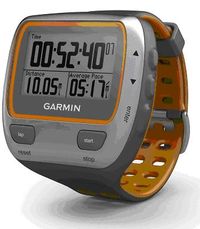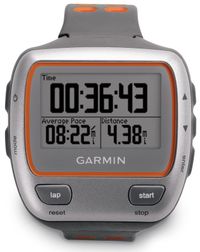Jake’s Journal: In Chicago marathon, Forerunner’s smart pacing cures my not-so-smart training
 The first few miles are more about holding back and not getting caught up in the rush – especially when my college buddy Chris, with Boston qualifying in mind, took off through the crowd to join the 3:10 pace group. I, on the other hand, settled into a nice 8-minute-mile clip and made friends with the 3:30 pace group. The contrast to 2007 was obvious from the start, as the starting gun followed a clothes explosion of several layers that had protected us from freezing temperatures and would later be donated to homeless shelters. Two years ago, most people showed up to the staging area in singlets and shorts.
The first few miles are more about holding back and not getting caught up in the rush – especially when my college buddy Chris, with Boston qualifying in mind, took off through the crowd to join the 3:10 pace group. I, on the other hand, settled into a nice 8-minute-mile clip and made friends with the 3:30 pace group. The contrast to 2007 was obvious from the start, as the starting gun followed a clothes explosion of several layers that had protected us from freezing temperatures and would later be donated to homeless shelters. Two years ago, most people showed up to the staging area in singlets and shorts.
The 10K mark was affirmation that I was running a “smart” race, nice and steady, with the first 6.2 miles officially at a 7:56 pace to put me on target for 3:27:59. The following 7 miles were more of the same – aside from a quick pit stop that necessitated a 7-minute mile to catch up – and I crossed the halfway point at 1:44:55, an 8-minute pace that forecast out at a 3:29:44 finish.
The problem with those predicted finish times is that they don’t factor in one small part of the second half of the race: Getting tired. Thanks to my abbreviated training, anything beyond the 14-mile mark was uncharted territory this fall. But a new friend motivated me to keep pushing. Running his second marathon, this high school teacher is starting a cross-country program at a Chicago suburb. At the 18-mile mark, I could tell I was holding him back, and I wasn’t ready to scrap the 8-minute miles that Forerunner was showing me. So I wished him well and soon hit the 30K mark (just shy of 19 miles) at 7:56 average, on pace for 3:27.59. More proof that I run faster when I’m gabbing.
 After my new friend disappeared, the mind games began. If I can make it to 20, I’ll walk a bit. But then I hit 20 and remembered that in KC, I didn’t walk until 21. So I made it to 22 before walking through a water station, but then I saw my lap pace climbing quickly with every slower footstep. So I picked it up, slowed it down, picked it up until I was still on pace to hit 3:30 when I rounded the second-to-last corner – the one where, two years ago, I was told by police to stop running as the clocks were being turned off. This time, the cops and crowd were cheering me on by name (yes, I made a second race bib just for my name), but the final two-tenths of a mile start with the steepest climb of the entire race. It’s a cruel little trick on an otherwise flat course, but that final test to see if you’re going to hit the time that seemed attainable just moments earlier.
After my new friend disappeared, the mind games began. If I can make it to 20, I’ll walk a bit. But then I hit 20 and remembered that in KC, I didn’t walk until 21. So I made it to 22 before walking through a water station, but then I saw my lap pace climbing quickly with every slower footstep. So I picked it up, slowed it down, picked it up until I was still on pace to hit 3:30 when I rounded the second-to-last corner – the one where, two years ago, I was told by police to stop running as the clocks were being turned off. This time, the cops and crowd were cheering me on by name (yes, I made a second race bib just for my name), but the final two-tenths of a mile start with the steepest climb of the entire race. It’s a cruel little trick on an otherwise flat course, but that final test to see if you’re going to hit the time that seemed attainable just moments earlier.
On the final turn, the finish-line clock was ticking mercilessly until I stomped on the mat, raised my arms for the photographers and hit stop on my Forerunner 310XT. The official text update confirmed a PR of 3:30:21. Two years after setting out to run a 3:30 in Chicago, I had achieved my original goal and I had Garmin Connect data to prove it. Sure it was just a minute faster than my previous best last fall and still 20 minutes slower than Chris and his stellar 3:09, but Boston could wait. For three and a half hours, my fussy knee was an afterthought (until later in the evening when I could barely walk), and I had run the race the way that I wanted to run. There will be time for new goals, first of which is letting my knee get back to normal, and eventually another marathon.
The post Jake’s Journal: In Chicago marathon, Forerunner’s smart pacing cures my not-so-smart training appeared first on Garmin Blog.
Sample Block Quote
Praesent vestibulum congue tellus at fringilla. Curabitur vitae semper sem, eu convallis est. Cras felis nunc commodo loremous convallis vitae interdum non nisl. Maecenas ac est sit amet augue pharetra convallis nec danos.
Sample Paragraph Text
Praesent vestibulum congue tellus at fringilla. Curabitur vitae semper sem, eu convallis est. Cras felis nunc commodo eu convallis vitae interdum non nisl. Maecenas ac est sit amet augue pharetra convallis nec danos dui.
Cras suscipit quam et turpis eleifend vitae malesuada magna congue. Damus id ullamcorper neque. Sed vitae mi a mi pretium aliquet ac sed elitos. Pellentesque nulla eros accumsan quis justo at tincidunt lobortis denimes loremous. Suspendisse vestibulum lectus in lectus volutpat, ut dapibus purus pulvinar. Vestibulum sit amet auctor ipsum.

